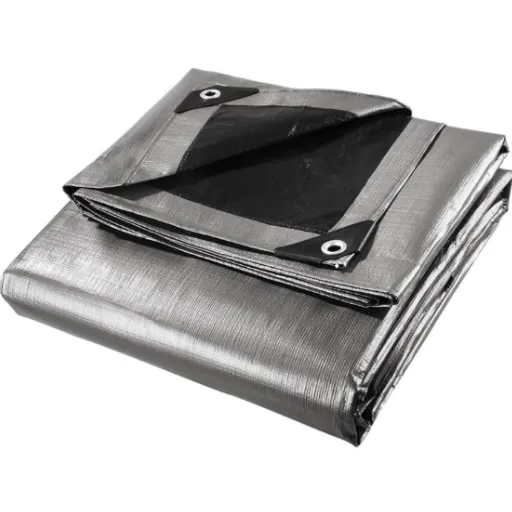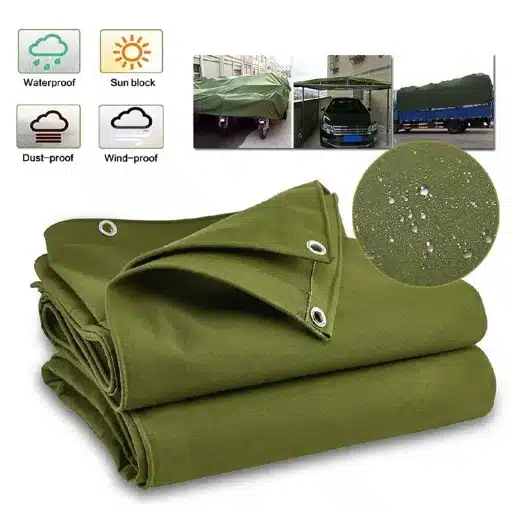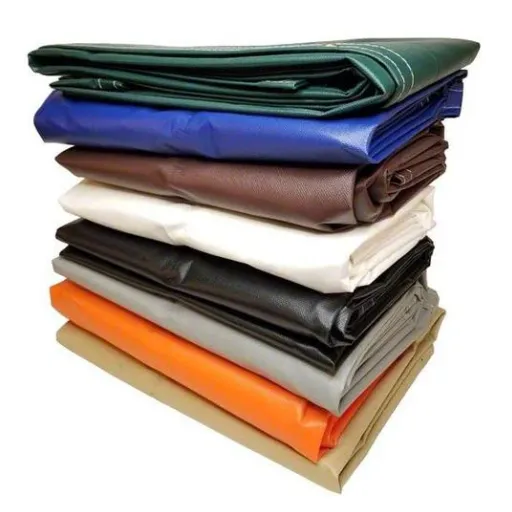Fire resistant tarps are the best solution for preventing any possible loss in the case of a fire. They have been used in places like scaffolding sites, power plants, outdoor locations, and for private purposes. These tough, fire retardant products are meant to guard the area against the fire in the first place by not allowing it to reach there or even resist the fire if it has already touched them. They are also ideal for those needing durable and secure solutions regardless of the environment being extreme or of high risk. In this guide, we will go through the fire retardant tarps with you and unveil their prime characteristics, advantages, and typical uses. With the completion of this reading, you will be well-versed in how these indispensable aids can be used for safety and security in different situations.
Understanding Fire-Resistant Tarps
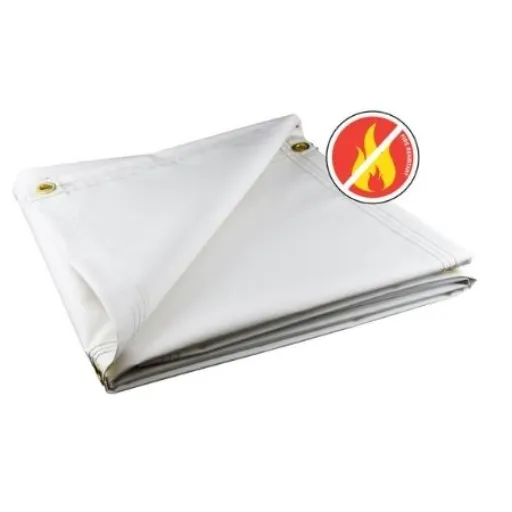
What are Fire-Resistant Tarps?
Fire Resistant Tarps are fire retardant canvas coverings that can bear the scorching heat and flames; otherwise, they would be easily burnt or ruined in the process. The products are made mainly of fiberglass, silicone-coated fibers, or flame-retardant polyethylene which assure the good high-temperature and fire resistance properties. These tarpaulins are being put through firm testing, e.g., NFPA 701 or CPAI-84 – thereby, securing the reliability in the diverse hazardous environments. Fire Resistant Tarps are typical for the construction site, welding, and industrial plants where fire hazards are present as they serve as barriers for the protection of equipment, structures, and workers. Their multi-purpose and robust nature render them priceless assets for safety in both everyday and emergency situations.
🔥 Key Characteristics
- ✓
Made from fiberglass, silicone-coated fibers, or flame-retardant polyethylene - ✓
Tested to meet NFPA 701 or CPAI-84 standards - ✓
Protect equipment, structures, and workers from fire hazards - ✓
Versatile applications across construction, welding, and industrial settings
How Fire Retardant Materials Work
Fire retardant materials are capable of doing the task by blocking one or more of the three components of fire, which are heat, oxygen, and fuel, the triangle that is necessary for the fire to burn. Such materials are tailored to either slow down or totally stop the spread of fire. In the case of heat or flames, some fire retardant materials go through chemical reactions whereby a protective char layer is formed, and thus the flammable material becomes less flammable and is also insulated from further heat. While others liberate nonflammable gases so as to lower the amount of oxygen or cool down the area, thus the fire is effectively extinguished. Technology has advanced to a level that more efficient fire retardants have been developed that are not only effective but also environmentally safe, hence reducing both safety and sustainability concerns. These compounds can be used in textiles, coatings, and structural materials, which makes them applicable in various industries like construction, transportation, and emergency response.
The Fire Triangle: How Fire Retardants Work
Heat
Forms protective char layer to insulate against heat
Oxygen
Releases nonflammable gases to reduce oxygen levels
Fuel
Reduces flammability of materials through chemical reactions
Types of Fire-Resistant Tarps
Fire-resistant tarps are high-temperature and flame-resistant materials; therefore, they are indispensable in a lot of industrial and commercial applications. They are classified into various types according to their raw materials and performance characteristics:
1. Polyethylene (PE) Fire-Resistant Tarps
These are the fire-resistant tarpaulins made of woven polyethylene fabric which is treated with fire-retardant chemicals. They are light but at the same time strong and are mostly used in the areas of construction, agricultural fields and shelters that are temporary.
2. Vinyl-Coated Fire-Resistant Tarps
Vinyl coated tarps not only are strong but also resistant to heat. They are specifically made to last in harsh environments like industrial warehouses, welding magnets, and outdoor storage areas. Their waterproof attribute also makes them fit for use in inclement weather.
3. Silicone-Coated Fiberglass Tarps
Manufactured to resist extreme heat, silicone-coated fiberglass tarpaulins are just right for welding, fire blankets, and other applications that involve direct flame exposure. They are capable of withstanding high heat without losing toughness.
4. Canvas Fire-Resistant Tarps
These tarps are made using cotton or polyester canvas that has been treated, thus they have fire resistance but at the same time not very breathable. They can be used as coverings in construction, painting, and storage of equipment.
5. Aluminized Fire-Resistant Tarps
Tarps with an aluminized coating that acts as a barrier to heat are the ones referred to as aluminized fire-resistant tarps. They are the best choice in case of a radiant heat or very intense flames scenario. These ones are generally fit for firefighting or industrial applications where there is high heat up.
💡 Important Note: Tarp of every type is designed for a certain purpose, thus guaranteeing safety and long-lasting use in varying applications. It is very important to take into account material, intended use, and fire safety standards when making a choice on a tarp.
Key Features of Fire Retardant Tarps
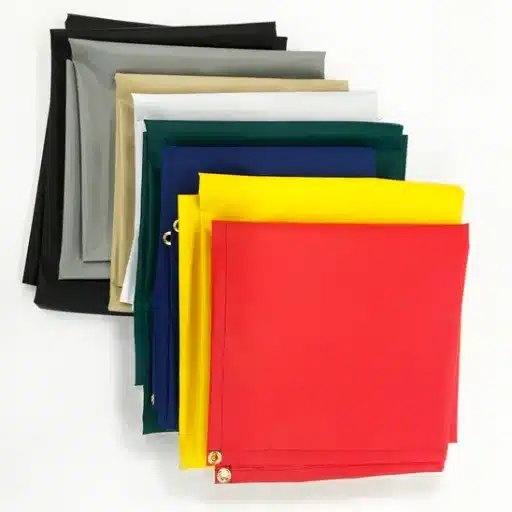
Material Composition: Poly vs. Vinyl vs. Canvas
While looking at the fire resistant certifications of poly, vinyl, and canvas tarps, it is evident how different every material is, and that their very properties refer to different applications. Poly tarps are mostly of lightweight operation, and very cost-efficient, and they resist water, with these qualities they perfectly serve for temporary or short-term employment. Polyethylene coatings are also heavily at the forefront in these tarps, as the coatings improve their strength and resistance to fire if coupled with the right treatments. Vinyl tarps as opposed to poly are known to be quite strong, and flexible while also able to survive the most rigorous weather conditions for a long time, including chemicals and UV rays. They stand out in industrial applications and outdoors where durability is important the most. Canvas tarps which are probably made of natural fibers like cotton are breathable and good for the environment. Fire-retardant canvas tarps that are treated are a great choice of application for the likes of construction and painting where moisture is absorbed and condensation reduced.
Vinyl tarps have been reported to be of great industrial use across the board where there is demand for fire resistance and a long life cycle because of their remarkable performance and their ability to survive even the most extreme conditions. That said, however, the choice of tarp material finally rests on application specifications, budget considerations, and preferred product life.
Flame Resistance Ratings and Certifications
When it comes to fire safety measures, flame resistance ratings play a super important role in the selection of tarps for such applications. The stated ratings specify the ability of the material to resist ignition and also to stop flames from spreading. NFPA 701 (National Fire Protection Association) is the most widely used certification among others, which takes into account the flammability of textiles and films. In case the tarp meets this certification, then it is usually found apart in industrial and public places such as construction sites, event spaces, and warehouses, among others.
Rising demand for compliance with more than one safety norm has been recently noted, the ones that are in common with the California Title 19 and CPAI-84 which are directed at tent and building fire retardant, there is now a major trend in tarp usage around that area. These certifications merger guarantees safety to the highest level, especially in areas where fire safety laws are very strict. Therefore, when buying flame-resistant tarps, it is mandatory to check the product’s test and compliance documents to ascertain that it meets local and the industry-wide safety requirements.
🏆 Important Fire Safety Certifications
NFPA 701
National Fire Protection Association standard for flammability of textiles and films
California Title 19
State fire safety standards for flame retardant materials
CPAI-84
Canvas Products Association International standard for tent and building fire retardancy
Heavy Duty Specifications for Tarps
Durability and high performance are of the utmost importance when it comes to heavy-duty tarps. Tarps of this kind are usually made from very strong materials like polyethylene, vinyl, or canvas and are often stitched with heavy-duty threads so that they are very strong and can be used for a long time. They are built to last through any weather conditions, not just tearing, but even UV rays, water, and endure extreme temperatures. Their main uses are in industrial settings and the like, hence they have reinforced edges with grommets attached to them for secure fastening and increased longevity.
Recent trends and developments indicate that heavy-duty tarps will also be widely used for special purposes like fire resistance, chemical resistance, or insulation. This wide range of applications makes tarpaulins very helpful across the industry. For good performance, one should look for tarps having a high mesh count, thick material gauge, and dependable coatings as these are the reasons for their heavy-duty specifications. Thus, when buying a tarp, consider these features to ensure that they match the intended application while also meeting safety and quality standards.
✅ Heavy Duty Tarp Specifications Checklist
- High Mesh Count: Ensures tighter weave and greater strength
- Thick Material Gauge: Provides enhanced durability and tear resistance
- Reinforced Edges: Prevents fraying and extends tarp lifespan
- Heavy-Duty Thread Stitching: Ensures seams stay intact under stress
- Quality Grommets: Allows for secure fastening and anchoring
- Dependable Coatings: Enhances weather resistance, UV protection, and overall performance
Applications of Fire Resistant Tarps
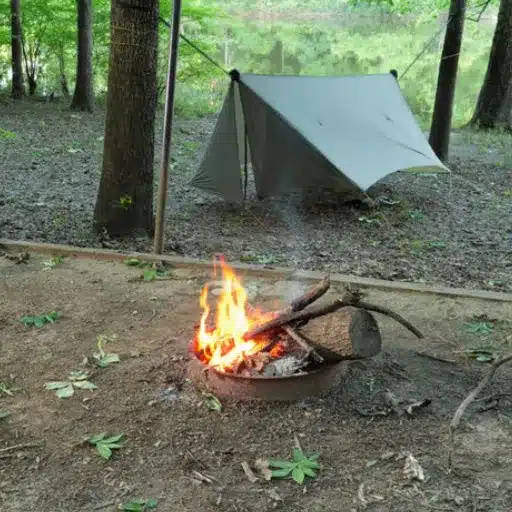
Outdoor Uses for Fire Retardant Heavy Duty Tarps
Fire retardant heavy duty tarps offer a great deal of versatility as well as reliability, so they are the perfect solution for outdoor applications that require safety and durability at the same time. One of the most common uses is where a shelter for a construction site is built with these tarps, and the protection of tools and equipment against bad weather is the main reason why this is done. The covering of hay, woodpiles, or other flammable materials is another common use of these tarps because they protect the chosen areas from the environment and thus lower the possibility of fire hazards at the same time. Fire-resistant tarps are often used in outdoor festivities by serving as canopies or awnings which allow for safety in areas that have open flames such as grilling spots or fire pits. They are also very convenient for camping, as the burning of the campfire will not be a factor in the safety and comfort of the campers’ being able to set up their tents close by. The strong material used in the tarps along with their fire-resistance makes them absolutely necessary for outdoor places where safety needs are very high and resilience is also required.
Common Outdoor Applications
🏗️ Construction Sites
Shelter for tools, equipment, and materials from weather elements
🌲 Woodpile Coverage
Protection of flammable materials while reducing fire hazards
🎪 Outdoor Events
Canopies and awnings for areas with grilling or fire pits
⛺ Camping
Safe tent setup near campfires with fire protection
Protection for Woodpiles and Furniture
It is very important to protect woodpiles and outdoor furniture from the elements so that they will not only last a long time but also be usable when needed. Fire-resistant tarps come as the most effective way of covering these items and protecting them from rain, snow, and UV rays. The growing number of inquiries about safeguarding outdoor materials indicates that users are increasingly interested in durable and cost-effective options. Fire-resistant tarps bring dual benefits of preventing weather damage and at the same time mitigating the hazard of accidental fires; therefore, they are a flexible solution for homeowners. Dependable outdoor protection is achieved through the combination of heavy-duty design and flame-retardancy in these tarps.
Industrial and Commercial Applications
The increasing number of searches for fire-resistant tarps is indicative of their wide-ranging industrial and commercial applications. Search data show that users are curious to know how these tarps might be applied in heavy-duty environments. Fire-resistant tarps will be a must for construction, manufacturing, and logistics sectors. They are usually used to prevent weather from affecting materials, machines, and work areas while at the same time lessening the risk of fire. For instance, at construction sites, these tarps cover scaffolding or building materials thereby assuring safety and longevity. In the same way, warehouses and factories can use them to create protective barriers which in turn will help to stop fire accidents. Thus, this combination of safety and practicality considers fire-resistant tarps as the main players in the market of businesses with risk management and operation efficiency on top of their agendas.
Choosing the Right Fire Retardant Tarp
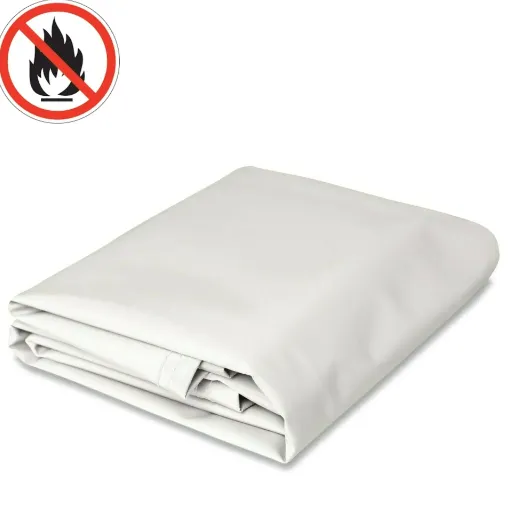
Key Considerations: Size, Thickness, and Grommet Spacing
Picking the appropriate fire retardant tarp, one of the first steps is to do thorough evaluation of its vital specifications that are to unlock full potential of the tarp for your given situation. Size is the most important aspect. The tarp should be large enough to cover the area or the material that you want to protect. Make sure that you have the right sizes based on your project or storage needs to prevent small coverage. Thickness is the decisive factor in longevity and resistance; thick tarps provide more protection against tears and abrasive weather, thus, they are the best for industrial use. Lastly, grommet spacing directly affects how convenient installation is and how secure the tarp is. The grommets of the tarp positioned appropriately allow it to be fastened tight and also will not cause an issue of flapping or movement if the tarp is set up in a windy area.
Overall, these considerations together with the newest trends in ‘s’ data, it seems that many users have a common choice when it comes to fire-resistant tarps as having custom-made sizes, heavy-duty (10 to 20 mils) thickness, and grommet spacing (typically every 18 inches) for added strength. So, buy a tarp that is in sync with these preferences and you can be sure of a tarp that is a good balance of safety, functionality, and practicality.
🎯 Selection Criteria for Fire Retardant Tarps
📏 Size
Must be large enough to cover the entire protected area
Tip: Measure carefully and allow for overhang
📐 Thickness
10-20 mils recommended for heavy-duty applications
Tip: Thicker = more durable and tear-resistant
⚙️ Grommet Spacing
Typically every 18 inches for secure fastening
Tip: Closer spacing = better wind resistance
UV Resistance and Waterproofing Features
UV resistance and waterproofing are two major features that are very often at the top of the list of essential factors that the consumers consider while making the choice of a tarp. The latest search data from indicates that there is a trend of increased demand for tarps that not only have but also high UV resistance and excellent waterproofing capacities at the same time which is hard to get. UV-resistant tarps are mainly made for sun protection, the end of this type of product is the breakdown of the material, thus, the application of such tarps is mainly for protecting outdoor items, or providing shade. The same goes for waterproof tarps: they are water proof against rain, snow, and moisture, and the items underneath are safe and damage-free. When it comes to quality, consumers often prefer tarps made from PE or PVC, as they are effective in providing both UV protection and waterproofing. Selecting a tarp with dual features guarantees that it will outlast and perform in varying weather conditions.
🌤️ Essential Weather Protection Features
UV Resistance
Prevents material breakdown from prolonged sun exposure and extends tarp lifespan
Waterproofing
Complete protection against rain, snow, and moisture damage to covered items
🏆 Recommended Materials: PE (Polyethylene) or PVC tarps for optimal dual protection
Cost vs. Quality: Finding the Best Value
In case of tarp selection, the tradeoff between cost and quality becomes an issue for many consumers. The search engine’s latest data shows that there is a trend that buyers are looking more often for low-cost options that do not compromise strength and performance. Tarps made with advanced materials like heavy-duty polyethylene or reinforced vinyl usually have a higher price tag; still, this is often the price customers are willing to pay in the long run, due to their much longer durability compared to that of their cheaper and lower-grade counterparts. At the same time, budget-conscious customers can still find lightweight tarpaulins, which serve as a solution for short-term or occasional use, thus, keeping their costs down during the whole process. In the end, getting the most value for your money implies determining what your specific needs are—whether it be durability, UV protection, or waterproofing—and then investing in a tarp with these features at a reasonable price point.
💰 Value Assessment Guide
✅ Premium Investment
- Heavy-duty polyethylene or reinforced vinyl
- Long-term durability (multiple years)
- Best for industrial and frequent use
- Higher upfront cost, lower lifetime cost
💡 Budget-Friendly
- Lightweight tarpaulin materials
- Short-term or occasional use
- Best for temporary projects
- Lower upfront cost, may need replacement
💡 Pro Tip: Identify your specific needs first, then match them with the appropriate tarp features at your price point for maximum value.
Maintenance and Care for Fire Resistant Tarps
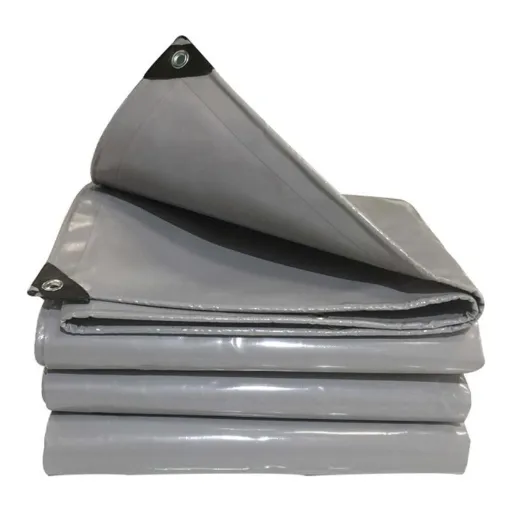
Cleaning and Storing Your Tarps
The appropriate upkeep of the fire-resistant tarps is a requirement to their full lives and maintaining their protective properties. Start your tarp cleaning by shaking off any debris that might be loose such as soil, leaves, or dust. A mixture of mild soap with warm water and a soft-bristle brush or sponge will be ideal for scrubbing the surface gently. Refrain from using strong detergents or bleach since they will destroy the protective covering of the tarp. Rinsing has to be done very well with clean water, so that no soap remains, and the tarp must be dried in air or in the sun before it is stored.
In the case of your tarps’ storage, make sure they are totally dry to stop mold or mildew growth. Neatly fold the tarp so that no creases or damage will occur and place it in a cool, dry area that is not directly under the sun or very hot/cold temperature. To make it even more secure, place the tarp in a storage bag so that dust and pests cannot reach it. Frequent conducting on inspection for any wear and tear, as well as fast fixing of any small holes and tears will make the tarp’s usability time last longer. Following these practices will keep your fire-resistant tarps dependable for the days to come.
🧼 Step-by-Step Cleaning & Storage Process
Cleaning Steps:
- Shake off loose debris (soil, leaves, dust)
- Mix mild soap with warm water
- Gently scrub surface with soft-bristle brush or sponge
- Avoid strong detergents or bleach
- Rinse thoroughly with clean water
- Air dry or sun dry completely before storage
Storage Best Practices:
- Ensure tarp is completely dry to prevent mold/mildew
- Fold neatly to avoid creases and damage
- Store in cool, dry area away from direct sunlight
- Avoid extreme hot/cold temperatures
- Use storage bag for protection against dust and pests
- Conduct regular inspections for wear and tear
Repairing Tears and Reinforcing Edges
Start healing your fire-proof tarp tears by cleaning the injured site very well so that dirt and debris are removed and the repair materials hold on better. Use a top-quality tarp repair tape or patch kit made only for fire-resistant materials because such products are designed to cope with the heat exposure and stay strong. If the rips are bigger, then a patch should be placed on both sides for extra strength. Edges that are reinforced will be less prone to the wear; so, either apply a heavy duty adhesive or sew on reinforcement strips along the periphery to strengthen the weak points.
Repairing a tarp is commonly associated with durability and longevity. The consensus is that maintaining it properly with regular cleaning routine, inspection, and prompt minor repair along with slow but steady application of the moisture and dirt blocking sealing compounds, will greatly improve the tarp life. Seaming bonding is essential for water-tightness and therefore it should be done by the best seam sealing material as stated by the search trends. Apart from that, the use of good quality tarps, which are the mainstay of your operation, along with frequent inspections will be a perfect partnership maximizing the life span and efficiency of your tarp.
🔧 Repair & Reinforcement Guidelines
🩹 For Small Tears
- Clean area thoroughly
- Use fire-resistant repair tape
- Apply patch kit designed for heat exposure
🔨 For Large Rips
- Apply patches on both sides
- Use heavy-duty adhesive
- Consider professional repair services
💪 Edge Reinforcement
- Apply reinforcement strips
- Use seam sealing materials
- Sew edges with heavy-duty thread
Longevity and Performance Over Time
The data obtained from the search engine indicates one of the most popular questions about fire-resistant tarps is ‘How to prolong their useful life without sacrificing their performance?’ It appears that the best recommendations according to the user trends include performing maintenance regularly and buying top-quality cartridges for border sealing. Besides, there is an increasing interest in UV protection coatings due to the continuous sun exposure being a major factor in tarp damage which has been revealed by the searches. If the users adopt these tactics, namely, regular cleaning, proper storage, and application of coatings when not in use, they would significantly increase both the durability and efficiency of their tarps. These practices continue to receive expert and community support as they underline the significance of prevention and care for lasting results.
🌟 Best Practices for Maximum Tarp Lifespan
- Regular Maintenance: Establish a consistent cleaning and inspection schedule
- Quality Border Sealing: Invest in premium sealing products for edges and seams
- UV Protection Coatings: Apply protective coatings to combat sun exposure damage
- Proper Storage: Keep tarps in controlled environments when not in use
- Prompt Repairs: Address minor damage immediately before it worsens
- Preventive Care: Use tarps within their rated specifications and conditions
Frequently Asked Questions (FAQ)
❓ What is a fire retardant tarp?
A fire retardant tarp is a cover that has been fire-resistant and flame-proof from the beginning. These are synthetic covers made from low-density polyethylene or vinyl, coated with chemicals that prevent the spread of fire. These tarps are perfect for construction sites, outdoor parties, or during a fire when the site already is the fire. With this type of tarp, the risk of flame-spreading to the protected area, the passing flames in the opposite direction, or the smoke all restricting the fire are minimised. They come in a wide range of thicknesses, including 12 mil for the toughest applications. A certified fire retardant tarp is a must for everyone wanting to be sure that they are acting according to the safety rules.
❓ How do heavy duty fire tarps differ from regular tarps?
Regular tarps don’t stand the test of heavy duty fire tarps. Regular tarps with their thin profiles are no match for thick reinforced polyethylene or heavy duty poly. The latter two options offer not just sturdiness but also fire protection. They come with several tan features such as rustproof aluminum grommets and strengthened edges to the already tough construction. These tarps are just the right type when you need something really resistant to both flames and weather, e.g., to cover firewood or put outside. Their tough nature ensures they do not die on you in difficult times; hence, they are a good choice for many different uses.
❓ Are flame retardant tarps waterproof?
Yes, many flame retardant tarps double up as waterproof and thus provide both fire and moisture protection at the same time. These tarps are made of either vinyl or heavy-duty poly which by their nature already are water-resistant. So, when you go for a tarp, you have to be wary of what the manufacturer claims or promises regarding fire and water resistances together with the protection they can provide for you. If features like reinforced corners and grommets are part of the tarp’s design, it is a signal that quality has been considered, and usability of the tarp in outdoor settings has been factored. The product specifications will always carry waterproof rating details.
❓ Can a fire resistant poly tarp be used for outdoor covers?
A fire resistant poly tarp is the best outdoor cover choice for it is strong and protective qualities. These tarps are made to resist the storm while giving us the needed fire protection at the same time. Another treatment done on them is putting UV coatings that last pretty long to prevent the sun’s rays from degrading them. Thus, when using the fire-resistant poly tarp as a cover for the outdoor furniture, it will keep the furniture dry, clean, and free from flames. For security, it’s better to choose tarps with heavy-duty construction and rustproof grommets because that way anchoring becomes easy.
❓ How can I certify the fire resistance of my tarp?
To have your tarp certified for fire resistance, you have to select the ones that abide by the standards set by the fire marshal. Most manufacturers supply a document or label affirming that their tarps have passed certain flame retardant criteria. It is also possible to verify if the tarp consists of PVC flame retardant materials, after which the tests of self-extinguishing properties are done. Getting tarps from trustworthy suppliers that have certified fire retardant varieties will enable you to relax in terms of safety and efficacy.
Conclusion
Fire resistant tarps are essential safety tools that provide reliable protection across a wide range of applications, from construction sites and industrial facilities to outdoor events and home use. By understanding the different types of fire-resistant materials, key features like certifications and specifications, and proper maintenance practices, you can select the right tarp for your specific needs. Whether you’re protecting valuable equipment, creating safe work environments, or safeguarding outdoor materials, investing in quality fire retardant tarps ensures both safety and peace of mind. Remember to prioritize certifications like NFPA 701 and CPAI-84, choose appropriate thickness and grommet spacing for your application, and maintain your tarps properly to maximize their lifespan and protective capabilities. With the right fire resistant tarp and proper care, you can significantly reduce fire hazards while ensuring durable, long-lasting protection in any environment.
📚 Reference Sources
- Defense Technical Information Center (DTIC) – Fire-Resistant Materials: Research Overview: This report provides insights into research on fire-safe materials, including applications in safety and protection. Link to source
- Humphrys – The Science Behind Fire Retardant Tarps: A detailed guide on the engineering and chemical treatments used in fire-retardant tarps, explaining their functionality and applications. Link to source
- University of Minnesota – Defensible Space for the Farm and Ranch: This educational material discusses creating safety buffers using fire-resistant materials, including tarps, to protect against wildfires. Link to source

